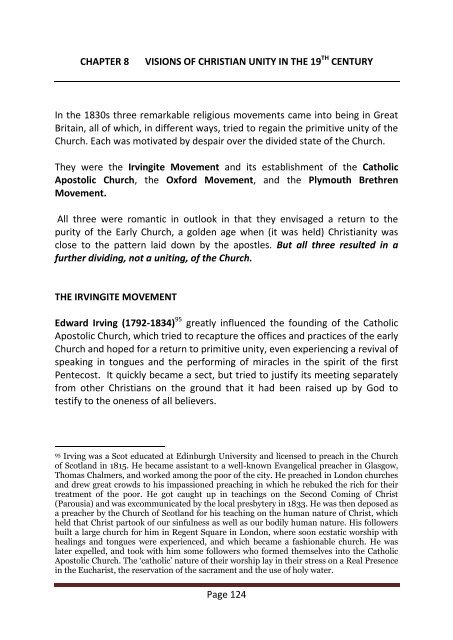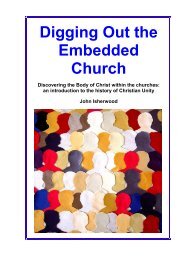Christian Unity (the book) - The Maranatha Community
Christian Unity (the book) - The Maranatha Community
Christian Unity (the book) - The Maranatha Community
You also want an ePaper? Increase the reach of your titles
YUMPU automatically turns print PDFs into web optimized ePapers that Google loves.
CHAPTER 8VISIONS OF CHRISTIAN UNITY IN THE 19 TH CENTURYIn <strong>the</strong> 1830s three remarkable religious movements came into being in GreatBritain, all of which, in different ways, tried to regain <strong>the</strong> primitive unity of <strong>the</strong>Church. Each was motivated by despair over <strong>the</strong> divided state of <strong>the</strong> Church.<strong>The</strong>y were <strong>the</strong> Irvingite Movement and its establishment of <strong>the</strong> CatholicApostolic Church, <strong>the</strong> Oxford Movement, and <strong>the</strong> Plymouth BrethrenMovement.All three were romantic in outlook in that <strong>the</strong>y envisaged a return to <strong>the</strong>purity of <strong>the</strong> Early Church, a golden age when (it was held) <strong>Christian</strong>ity wasclose to <strong>the</strong> pattern laid down by <strong>the</strong> apostles. But all three resulted in afur<strong>the</strong>r dividing, not a uniting, of <strong>the</strong> Church.THE IRVINGITE MOVEMENTEdward Irving (1792-1834) 95 greatly influenced <strong>the</strong> founding of <strong>the</strong> CatholicApostolic Church, which tried to recapture <strong>the</strong> offices and practices of <strong>the</strong> earlyChurch and hoped for a return to primitive unity, even experiencing a revival ofspeaking in tongues and <strong>the</strong> performing of miracles in <strong>the</strong> spirit of <strong>the</strong> firstPentecost. It quickly became a sect, but tried to justify its meeting separatelyfrom o<strong>the</strong>r <strong>Christian</strong>s on <strong>the</strong> ground that it had been raised up by God totestify to <strong>the</strong> oneness of all believers.95Irving was a Scot educated at Edinburgh University and licensed to preach in <strong>the</strong> Churchof Scotland in 1815. He became assistant to a well-known Evangelical preacher in Glasgow,Thomas Chalmers, and worked among <strong>the</strong> poor of <strong>the</strong> city. He preached in London churchesand drew great crowds to his impassioned preaching in which he rebuked <strong>the</strong> rich for <strong>the</strong>irtreatment of <strong>the</strong> poor. He got caught up in teachings on <strong>the</strong> Second Coming of Christ(Parousia) and was excommunicated by <strong>the</strong> local presbytery in 1833. He was <strong>the</strong>n deposed asa preacher by <strong>the</strong> Church of Scotland for his teaching on <strong>the</strong> human nature of Christ, whichheld that Christ partook of our sinfulness as well as our bodily human nature. His followersbuilt a large church for him in Regent Square in London, where soon ecstatic worship withhealings and tongues were experienced, and which became a fashionable church. He waslater expelled, and took with him some followers who formed <strong>the</strong>mselves into <strong>the</strong> CatholicApostolic Church. <strong>The</strong> ‘catholic’ nature of <strong>the</strong>ir worship lay in <strong>the</strong>ir stress on a Real Presencein <strong>the</strong> Eucharist, <strong>the</strong> reservation of <strong>the</strong> sacrament and <strong>the</strong> use of holy water.Page 124








